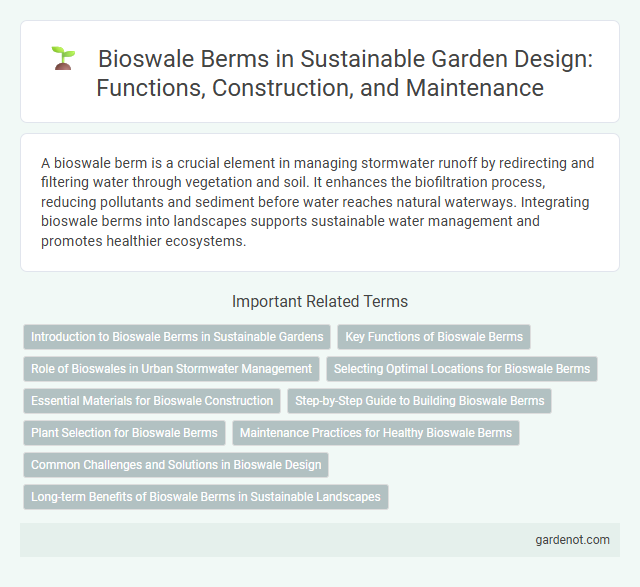A bioswale berm is a crucial element in managing stormwater runoff by redirecting and filtering water through vegetation and soil. It enhances the biofiltration process, reducing pollutants and sediment before water reaches natural waterways. Integrating bioswale berms into landscapes supports sustainable water management and promotes healthier ecosystems.
Introduction to Bioswale Berms in Sustainable Gardens
Bioswale berms enhance sustainable gardens by directing stormwater runoff through native vegetation, promoting natural filtration and soil infiltration. These berms consist of raised soil mounds designed to slow water flow, reduce erosion, and improve water quality by trapping sediments and pollutants. Integrating bioswale berms supports biodiversity, conserves water, and mitigates urban flooding in eco-friendly landscape designs.
Key Functions of Bioswale Berms
Bioswale berms serve as critical components in stormwater management by directing and slowing water flow, promoting filtration and infiltration into the soil. These berms enhance pollutant removal by trapping sediments, nutrients, and heavy metals, improving water quality before it reaches natural water bodies. Their vegetated structure stabilizes soil, reduces erosion, and supports habitat for beneficial microorganisms and pollinators.
Role of Bioswales in Urban Stormwater Management
Bioswale berms act as critical components in urban stormwater management by facilitating the infiltration and filtration of runoff, reducing pollutant loads before water reaches municipal drainage systems. These vegetated channels use engineered soil layers and native plants to slow water flow, enhancing sediment deposition and nutrient uptake, thus mitigating flood risks and improving water quality. Integrating bioswale berms into urban landscapes promotes sustainable water cycle management by harnessing natural processes to address stormwater challenges efficiently.
Selecting Optimal Locations for Bioswale Berms
Selecting optimal locations for bioswale berms involves analyzing topographical features, soil permeability, and existing water flow patterns to enhance stormwater management and pollutant filtration. Areas prone to runoff accumulation and low infiltration rates benefit most from strategically placed berms, which slow water flow and promote infiltration. Integrating bioswale berms within urban landscapes requires evaluating proximity to impervious surfaces and potential sources of pollutants to maximize environmental impact and hydraulic efficiency.
Essential Materials for Bioswale Construction
Bioswale berm construction requires essential materials such as engineered soil media, which typically consist of sand, compost, and topsoil to ensure proper drainage and pollutant filtration. Incorporating native plants adapted to local hydrological conditions enhances pollutant uptake and erosion control. Permeable layers of gravel or crushed stone support water infiltration and prevent soil compaction within the bioswale system.
Step-by-Step Guide to Building Bioswale Berms
Constructing a bioswale berm begins with site assessment and soil testing to determine appropriate slope and absorption rates. Excavate a shallow trench along the planned contour, then build up berms using native soil or compost to direct runoff into the swale. Plant native vegetation on the berm to enhance filtration, prevent erosion, and maximize water retention efficiency.
Plant Selection for Bioswale Berms
Selecting native, drought-tolerant plants with deep root systems is crucial for bioswale berms to enhance stormwater infiltration and prevent soil erosion. Species such as sedges, rushes, and wildflowers improve water filtration by stabilizing the soil and absorbing pollutants. Incorporating a diverse mix of perennial grasses and native shrubs boosts biodiversity while maintaining berm structure and function.
Maintenance Practices for Healthy Bioswale Berms
Regular maintenance of bioswale berms involves inspecting soil stability, removing accumulated debris, and managing vegetation to prevent clogging and ensure efficient water infiltration. Periodic sediment removal and pruning of native plants help maintain the berm's filtration capacity and aesthetic appeal. Implementing a monitoring schedule for erosion and nutrient buildup supports long-term bioswale functionality and promotes healthy urban stormwater management.
Common Challenges and Solutions in Bioswale Design
Bioswale berms frequently face challenges such as soil erosion, clogging from sediment buildup, and poor vegetation establishment, which can compromise their water filtration efficiency. Implementing engineered soil mixes with high infiltration rates and incorporating native, deep-rooting plants mitigate erosion and enhance pollutant absorption. Regular maintenance practices like sediment removal and adaptive vegetation management ensure long-term performance and resilience in bioswale designs.
Long-term Benefits of Bioswale Berms in Sustainable Landscapes
Bioswale berms enhance water filtration by directing runoff through vegetation and soil layers, promoting groundwater recharge and reducing pollutants. Their long-term benefits include improved stormwater management, erosion control, and habitat creation for native wildlife. Implementing bioswale berms supports sustainable landscapes by maintaining ecosystem health and enhancing urban resilience against flooding.
Bioswale berm Infographic

 gardenot.com
gardenot.com